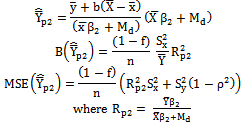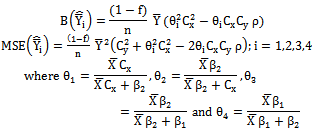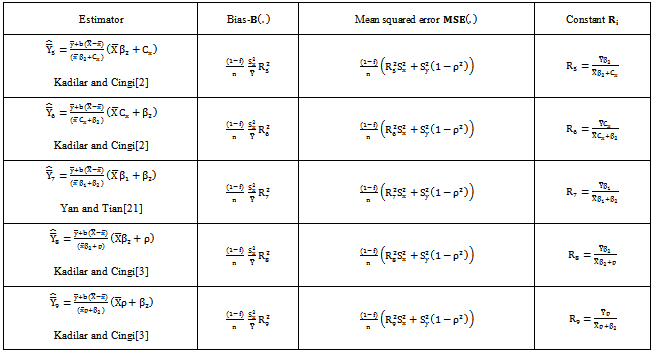-
Paper Information
- Previous Paper
- Paper Submission
-
Journal Information
- About This Journal
- Editorial Board
- Current Issue
- Archive
- Author Guidelines
- Contact Us
American Journal of Mathematics and Statistics
p-ISSN: 2162-948X e-ISSN: 2162-8475
2012; 2(4): 95-100
doi: 10.5923/j.ajms.20120204.05
Modified Ratio Estimators Using Known Median and Co-Efficent of Kurtosis
J. Subramani , G. Kumarapandiyan
Department of Statistics, Pondicherry University, R V Nagar, Kalapet, Puducherry ,605014, India
Correspondence to: J. Subramani , Department of Statistics, Pondicherry University, R V Nagar, Kalapet, Puducherry ,605014, India.
| Email: |  |
Copyright © 2012 Scientific & Academic Publishing. All Rights Reserved.
The present paper deals with two modified ratio estimators for estimation of population mean of the study variable using the linear combination of the known population values of the Median and the Co-efficient of Kurtosis of the auxiliary variable. The biases and the mean squared errors of the proposed estimators are derived and are compared with that of existing modified ratio estimators for certain natural populations. Further we have also derived the conditions for which the proposed estimators perform better than the existing modified ratio estimators. From the numerical study it is also observed that the proposed modified ratio estimators perform better than the existing modified ratio estimators.
Keywords: Auxiliary Variable, Bias, Modified Ratio Estimators, Simple Random Sampling
Article Outline
1. Introduction
- Consider a finite population
 of N distinct and identifiable units. Let Y a study variable with value
of N distinct and identifiable units. Let Y a study variable with value  measured on
measured on  giving a vector
giving a vector  The problem is to estimate the population mean
The problem is to estimate the population mean with some desirable properties on the basis of a random sample selected from the population U The simplest estimator of population mean is the sample mean obtained by using simple random sampling without replacement, when there is no additional information on the auxiliary variable available. Sometimes in sample surveys, along with the study variable Y, information on auxiliary variable X , correlated with Y is also collected. This information on auxiliary variabl X, may be utilized to obtain a more efficient estimator of the population mean. Ratio method of estimation, using auxiliary information is an attempt made in this direction. Before discussing further about the modified ratio estimators and the proposed modified ratio estimators the notations to be used are described. •
with some desirable properties on the basis of a random sample selected from the population U The simplest estimator of population mean is the sample mean obtained by using simple random sampling without replacement, when there is no additional information on the auxiliary variable available. Sometimes in sample surveys, along with the study variable Y, information on auxiliary variable X , correlated with Y is also collected. This information on auxiliary variabl X, may be utilized to obtain a more efficient estimator of the population mean. Ratio method of estimation, using auxiliary information is an attempt made in this direction. Before discussing further about the modified ratio estimators and the proposed modified ratio estimators the notations to be used are described. •  Population size•
Population size•  Sample size•
Sample size•  Sampling fraction•
Sampling fraction•  Study variable•
Study variable•  Auxiliary variable•
Auxiliary variable•  Population means•
Population means•  Sample means•
Sample means•  Population standard deviations•
Population standard deviations•  Co-efficient of variations•
Co-efficient of variations•  Co-efficient of correlation•
Co-efficient of correlation•  , Co-efficient of skewness of the auxiliary variable•
, Co-efficient of skewness of the auxiliary variable•  , Co-efficient of kurtosis of the auxiliary variable•
, Co-efficient of kurtosis of the auxiliary variable•  Median of the auxiliary variable•
Median of the auxiliary variable•  Bias of the estimator•
Bias of the estimator•  Mean squared error of the estimator•
Mean squared error of the estimator•  Existing (proposed) modified ratio estimator of
Existing (proposed) modified ratio estimator of  The Ratio estimator for estimating the population mean
The Ratio estimator for estimating the population mean  of the study variable Y is defined as
of the study variable Y is defined as | (1) |
 The Ratio estimator given in (1) is more precise than the simple random sample mean, when there exists a positive correlation between
The Ratio estimator given in (1) is more precise than the simple random sample mean, when there exists a positive correlation between en [8] has presented the historical developments of the ratio method of estimation starting from the year 1662. Hence the readers, who are interested in knowing more details on the chronological developments of the ratio methods of estimation, are referred to Sen [8] and the references cited therein. Further improvements are also achieved on the classical ratio estimator by introducing a large number of modified ratio estimators with the use of known parameters like, Co-efficient of Variation, Co-efficient of Kurtosis, Co-efficient of Skewness, Population Correlation Coefficient and Median. It is to be noted that “the existing modified ratio estimators” means the list of modified ratio estimators to be considered in this paper unless otherwise stated. It does not mean to the entire list of modified ratio estimators available in the literature. For a more detailed discussion on the ratio estimator and its modifications one may refer to Cochran[1], Kadilar and Cingi[2,3], Koyuncu and Kadilar[4], Murthy[5], Prasad[6], Rao[7], Singh[10], Singh and Tailor[11,12], Singh et.al[13], Sisodia and Dwivedi[14], Srivastava [15,16], Subramani and Kumarapandiyan[17,18], Upadhyaya and Singh[19], Walsh [20], Yan and Tian[21] and the references cited there in.The lists of modified ratio estimators together with their biases, mean squared errors and constants available in the literature are classified into two classes namely Class 1, Class 2 and are given respectively in Table 1 and Table 2 respectively.The modified ratio estimators given in Table 1 and Table 2 are biased but have minimum mean squared errors compared to the classical ratio estimator. The list of estimators given in Table 1 and Table 2 uses the known values of the parameters like
en [8] has presented the historical developments of the ratio method of estimation starting from the year 1662. Hence the readers, who are interested in knowing more details on the chronological developments of the ratio methods of estimation, are referred to Sen [8] and the references cited therein. Further improvements are also achieved on the classical ratio estimator by introducing a large number of modified ratio estimators with the use of known parameters like, Co-efficient of Variation, Co-efficient of Kurtosis, Co-efficient of Skewness, Population Correlation Coefficient and Median. It is to be noted that “the existing modified ratio estimators” means the list of modified ratio estimators to be considered in this paper unless otherwise stated. It does not mean to the entire list of modified ratio estimators available in the literature. For a more detailed discussion on the ratio estimator and its modifications one may refer to Cochran[1], Kadilar and Cingi[2,3], Koyuncu and Kadilar[4], Murthy[5], Prasad[6], Rao[7], Singh[10], Singh and Tailor[11,12], Singh et.al[13], Sisodia and Dwivedi[14], Srivastava [15,16], Subramani and Kumarapandiyan[17,18], Upadhyaya and Singh[19], Walsh [20], Yan and Tian[21] and the references cited there in.The lists of modified ratio estimators together with their biases, mean squared errors and constants available in the literature are classified into two classes namely Class 1, Class 2 and are given respectively in Table 1 and Table 2 respectively.The modified ratio estimators given in Table 1 and Table 2 are biased but have minimum mean squared errors compared to the classical ratio estimator. The list of estimators given in Table 1 and Table 2 uses the known values of the parameters like  and their linear combinations. However, it seems, no attempt is made to use the linear combination of known values of the Median and Co-efficient of Kurtosis of the auxiliary variable to improve the ratio estimator. The points discussed above have motivated us to introduce two modified ratio estimators using the linear combination of the known values of Median and Co-efficient of Kurtosis of the auxiliary variable. It is observed that the proposed estimators perform better than the existing modified ratio estimators listed in Table 1 and Table 2.
and their linear combinations. However, it seems, no attempt is made to use the linear combination of known values of the Median and Co-efficient of Kurtosis of the auxiliary variable to improve the ratio estimator. The points discussed above have motivated us to introduce two modified ratio estimators using the linear combination of the known values of Median and Co-efficient of Kurtosis of the auxiliary variable. It is observed that the proposed estimators perform better than the existing modified ratio estimators listed in Table 1 and Table 2. 2. Proposed Modified Ratio Estimators
- In this section, we have suggested two modified ratio estimators using the linear combination of Median and Co-efficient of Kurtosis of the auxiliary variable. The proposed modified ratio estimators for estimating the population mean
 together with the first degree of approximation, the biases and mean squared errors and the constants are given below:
together with the first degree of approximation, the biases and mean squared errors and the constants are given below: | (2) |
 | (3) |
3. Efficiency Comparison
- For want of space; for the sake of convenience to the readers and for the ease of comparisons, the modified ratio estimators given in Table 1, Table 2 are represented into two classes as given below. Further it is to be noted that the proposed estimator
 is compared with that of the modified ratio estimators listed in Class 1 whereas the proposed estimator
is compared with that of the modified ratio estimators listed in Class 1 whereas the proposed estimator  is compared with that of the modified ratio estimators listed in Class 2.
is compared with that of the modified ratio estimators listed in Class 2.
|
|
 listed in the Table 1 are represented in a single class (say, Class 1), which will be very much useful for comparing with that of proposed modified ratio estimators and are given below:
listed in the Table 1 are represented in a single class (say, Class 1), which will be very much useful for comparing with that of proposed modified ratio estimators and are given below: | (4) |
 listed in the Table 2 are represented in a single class (say, Class 2), which will be very much useful for comparing with that of proposed modified ratio estimators and are given below:
listed in the Table 2 are represented in a single class (say, Class 2), which will be very much useful for comparing with that of proposed modified ratio estimators and are given below: | (5) |
 | (6) |
 | (7) |
 is more efficient than the existing modified ratio estimators given in Class 1,
is more efficient than the existing modified ratio estimators given in Class 1,  and are given below:
and are given below: | (8) |
 is more efficient than the existing modified ratio estimators given in Class 2,
is more efficient than the existing modified ratio estimators given in Class 2,  and are given below:
and are given below: | (9) |
4. Numerical Study
- The performances of the proposed modified ratio estimators are assessed with that of existing modified ratio estimators listed in Table 1 and Table 2 for certain natural populations. In this connection, we have considered four natural populations for the assessment of the performances of the proposed modified ratio estimators with that of existing modified ratio estimators. The population 1 and 2 are taken from Singh and Chaudhary[9] given in page 177, population 3 is taken from Singh and Chaudhary[9] given in page 141 and population 4 is taken from Cochran[1] given in page 152. The population parameters and the constants computed from the above populations are given below:The constants of the existing and proposed modified ratio estimators for the above populations are given in the Table 4 and Table 5:The biases of the existing and proposed modified ratio estimators for the above populations are given in the Table 6 and Table 7:The mean squared errors of the existing and proposed modified ratio estimators for the above populations are given in the Table 8 and Table 9:From the values of Table 6 and Table 7, it is observed that the bias of the proposed modified ratio estimator
 is less than the biases of the existing modified ratio estimators
is less than the biases of the existing modified ratio estimators  given in Class 1 and the bias of the proposed modified ratio estimator
given in Class 1 and the bias of the proposed modified ratio estimator  is less than the biases of the existing modified ratio estimators given
is less than the biases of the existing modified ratio estimators given  in Class 2. Similarly from the values of Table 8 and Table 9, it is observed that the mean squared error of the proposed modified ratio estimator
in Class 2. Similarly from the values of Table 8 and Table 9, it is observed that the mean squared error of the proposed modified ratio estimator  is less than the mean squared errors of the existing modified ratio estimators given
is less than the mean squared errors of the existing modified ratio estimators given  in Class 1 and the mean squared error of the proposed modified ratio estimator
in Class 1 and the mean squared error of the proposed modified ratio estimator is less than the mean squared errors of the existing modified ratio estimators
is less than the mean squared errors of the existing modified ratio estimators  iven in Class 2.
iven in Class 2.
|
|
|
|
|
|
|
5. Conclusions
- In this paper we have proposed two modified ratio estimators using linear combination of Median and Co-efficient of Kurtosis of the auxiliary variable. The biases and mean squared errors of the proposed estimators are obtained and compared with that of existing modified ratio estimators. Further we have derived the conditions for which the proposed estimators are more efficient than the existing modified ratio estimators. We have also assessed the performances of the proposed estimators for some known populations. It is observed that the biases and mean squared errors of the proposed estimators are less than the biases and mean squared errors of the existing modified ratio estimators for certain known populations. Hence we strongly recommend that the proposed modified estimators may be preferred over the existing modified ratio estimators for the use of practical applications.
ACKNOWLEDGEMENTS
- The authors are thankful to the referees whose constructive comments led to improvement in the paper. The second author wishes to record his gratitude and thanks to the Vice Chancellor, Pondicherry University and other University authorities for having given the financial assistance to carry out this research work through the University Fellowship.
 Abstract
Abstract Reference
Reference Full-Text PDF
Full-Text PDF Full-Text HTML
Full-Text HTML







